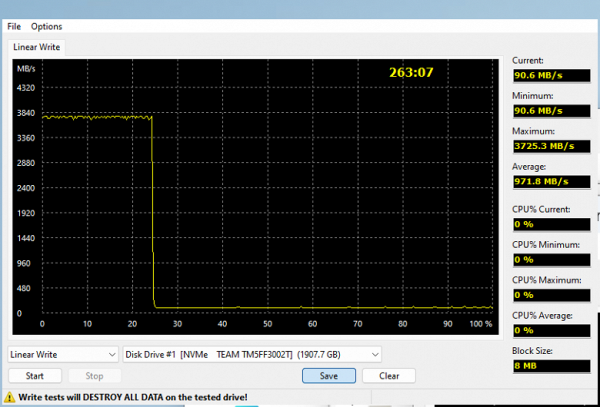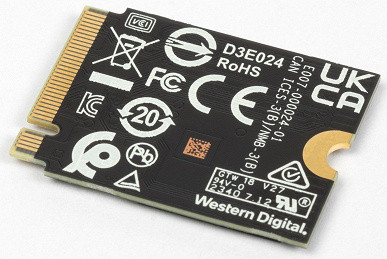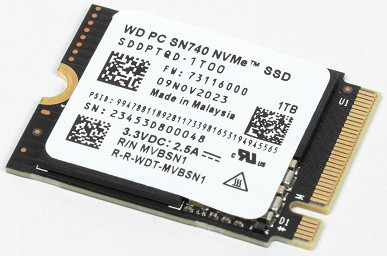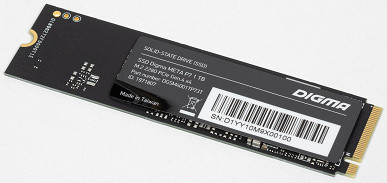We recently tested one M.2 2230 SSD and discussed what it could be useful for. For most desktop users, space is at a premium, so using larger form factors like U.2/U.3 is more convenient and allows for better device cooling. On the other hand, M.2 SSDs mounted directly on the board can compete for space and cool air with other components. Large cases allow for a large amount of flash memory to be placed inside, which can be useful, but often leaves users with no choice between a large number of drives.
Why are most SSDs in the M.2 form factor? The main reason is the increasing popularity of compact systems such as laptops and mini-PCs. Installing an M.2 SSD in such systems is more convenient and cost-effective than using larger form factors. Therefore, consumer SSD models are presented in such a form factor to meet market demand. In addition, there are more compact systems for which even the M.2 2280 form factor is too large. This led to shorter versions of the standard, such as 2242 and 2230, to meet the needs of such systems.

Therefore, most manufacturers prefer the M.2 2280 format as a compromise solution. However, the compromise usually does not suit everyone. For desktop computers, this format may be inconvenient due to its excessive miniature size, which often interferes with the necessary components. And for compact systems it is either too large or simply redundant. Most OEM SSDs used in computers are equipped with four-channel controllers without a buffer, and the memory in many models is packaged on a single chip. Even major manufacturers like Samsung and WD offer products with similar designs, even if they come in the M.2 2280 form factor.
Until recently, many users encountered difficulties when trying to replace the drive, as retail stores often did not have suitable options. However, the situation began to change last year, and more compact SSDs began to appear in the retail segment. One interesting example is the WD Black SN770M. Interestingly, the company has changed virtually nothing in its line, simply adding the SN770M model to retail channels, which was adapted for compact systems. This could be one of the most interesting compact SSD solutions on the market.
WD PC SN740 1 TB
We believe WD's offering in the compact segment is currently superior to the competition for several reasons. One of the features of the technology is the packaging of all memory crystals into one chip. This approach was introduced into the initial models of NVMe drives in the Blue SN500 line and was subsequently extended to all other Blue, Green and low-cost Black models. In the case of a 2280 format board, such a compact package may be slightly more expensive than less integrated options, but in this segment space is usually not a limiting factor.

When it comes to M.2 2230 SSDs, there are practically no options for development. Almost all models in this segment look the same, since there is enough space on the board for exactly one flash memory chip and a little for the controller. It is not possible to install something larger, like four-channel models, or add space for DRAM. Therefore, SSDs in this form factor are almost all identical. There are also more compact options where the controller and flash memory are combined in one assembly, but they have their drawbacks and are not very popular among manufacturers.
WD has been producing bufferless quad-channel SSDs for a long time. Since the company sells ready-made SSDs and not controllers, competition in this market is not so strong. This allows WD to make better products than some of its competitors. Of course, with the advent of new models from competitors, the situation becomes more complex, but WD models have already proven themselves in the market.
As for memory, at the moment no one has yet learned to combine more than 16 crystals into one chip. Therefore, the volume of compact SSDs is limited by the size of the memory crystals. TLC memory has a capacity of 512 Gbit per die, so the SSD capacity limit is 1 TB. If a larger volume is needed, QLC memory is used, where each crystal has a capacity of 1 Tbit or even 1.33 Tbit. Thus, to achieve 2 TB of memory capacity, 12-16 crystals are enough. WD also offers 112-layer BiCS5 memory, which has 1.33Tbit TLC die. This provides more choice for creating SSDs with different memory capacities.

We decided to go with a one-terabyte SSD instead of the more rare two-terabyte option for several reasons. First, two-terabyte SSDs typically cost significantly more than their one-terabyte counterparts. While WD already sells the SN770M SSD directly through its website, and the prices for the 1TB and 2TB models differ by half, prices for the 2TB SN740 models can be two and a half times higher elsewhere.
Secondly, to fully compare the SN740 and SN770 SSDs, we needed to study them directly. It's possible that they operate differently, and using a two-terabyte model could skew the comparison. We examined the one-terabyte version of the SN770, which allowed us to make a more accurate comparison with other similar models.

And this is no coincidence. The issue of memory also plays a key role here. The company has 512Gb BiCS5 TLC dies that come in two types — fast 4-flat and slow 2-flat. For two-terabyte models, only slow 2-flat ones are used. For WD Blue SSDs this is not a problem, since they use 2-flat crystals even up to a terabyte, and the transition to two-terabyte models occurs smoothly: both internal and external parallelization remain the same. And in the case of Black, models with a capacity of 1 terabyte and less have 4-flat crystals, so the two-terabyte version is slower.
Despite this, for now the 2TB PC SN740 or Black SN770M remains a very attractive proposition for the M.2 2230 format. All other models typically use QLC memory, which makes them even slower. However, over time, this advantage will be smoothed out, since the new TLC memory is already supplied in the form of terabit crystals. We assume that WD will also update its Black line in all versions, including two-terabyte versions. They already have a 162-layer BiCS6 that supports 1 terabit with 4 planes. This will improve sequential speeds up to 7 GB/s in this segment, which will become a competitive advantage.
Testing
Samples for comparison

We focused on four main pillars. Among them, of course, the WD Black SN770 stands apart — we compared it mainly with it. While it would be nice to also have someone from the OEM segment for comparison, most of these SSDs are at a level lower than the SN740. The only exception is perhaps the Samsung PM9A1, but it is already at a higher level. Samsung also has the PM9B1, which is a direct competitor in the range, and it's also available in «shortened» formats. However, its study will be the subject of the following materials.

So let's look at this from the other side — let's compare by size. Our selection is fairly limited at the moment: we recently tested the Phison E21T-based TeamGroup MP44S using Micron's 176-layer QLC memory. Technically, it's on par with, if not lower than, many other 2TB M.2 2230 SSDs. Most of these SSDs are equipped with three-bit (TLC) memory, which, as already mentioned, is most often limited to a capacity of 1 TB. The only exceptions are a few models, among which the pair WD PC SN740 and Black SN770M stand out. However, as mentioned earlier, their performance on 1TB capacity can also be faster. Thus, a direct comparison of speed and capacity seems logical.
And another pair of SSD Digma — Meta M6 based on Maxio MAP1602 using 232-layer YMTC memory and Meta P7 based on Phison E27T with 162-layer Kioxia BiCS6. Why them? As mentioned earlier, when the WD Black SN770 appeared on the market, it seemed like an excellent solution. At that time, most four-channel bufferless platforms only weakly competed with the more affordable WD Blue SN570 model, while the Black SN770 successfully made its way to the level of top-end SSDs. Although not too deep, he was ahead of his competitors. However, the situation has changed since then: competitors have stepped up their game, new budget models are aiming to achieve speeds of up to 7 GB/s in sequential operations, which makes the old WD model a little obsolete. Therefore, we believe that the company should update its line to something more modern. However, is it really worth worrying or can we just accept the current state of affairs for now? This is worth assessing directly if possible. Additionally, the Digma Meta P7 uses the same memory that will be used in the new WD line when it arrives. Therefore, it is interesting to compare performance. In addition, these platforms are also suitable for the launch of compact models that are likely to appear in the near future.
Filling with data


There was a strong desire to finally find and test a real WD Black SN770M — since the PC SN740, contrary to some forecasts, does not completely replicate the “big” Black SN770. The write speed to the SLC cache remains the same, the settings do the same, but after the cache is exhausted, the data is distributed more slowly. However, it wouldn't be surprising if that 100MB/s or so was lost on purpose — the controller is likely deliberately slowing down the process to reduce heat, especially given the maximum write speed specified for the cache. Nameplate speeds are specified only for the cache, and everything else can formally be different. However, it is impossible to determine from the available data whether this is a feature of the OEM line or the 2230 format. It will be necessary to test another similar modification on occasion in order to finally decide.

You don’t have to worry about the little things, because the main thing in the end is to avoid such situations. Even more affordable TLC models are generally capable of achieving very high write speeds within the cache and acceptable ones outside of it. Even with suboptimal caching settings for large storage volumes, the native write speed directly to the TLC array of the SSDs of this WD family is approximately 1.5-1.6 GB/s. We don’t see this because the company uses all available cells for SLC caching. For QLC SSDs, caching is critical, since only through it can normal speeds be achieved, otherwise speeds can be at the level of hard drives in case of misses. In practice, SSDs hit the cache much more often than not (that's why everyone strives to increase it), which makes it quite comfortable to use QLC. However, it is better to avoid such risks if possible.


When we said that WD's «light black» SSDs might become obsolete, we meant that ambitious new competitors are aiming for more, and they might even be cheaper. However, not all SSDs are created equal — for example, the Phison E27T is a little weaker, so even with a decrease in SLC cache capacity, it may not be able to write its “tails” as quickly. If WD followed the same path, most likely the performance graph would be almost the same as that of the Digma Meta M6. Such SSDs appeared on the market only last year, while the SN740/SN770 have been around for a couple of years. But today the situation is different.
Maximum speed characteristics
Low-level benchmarks, including CrystalDiskMark 8.0.1, have long been limited in their ability to test SSDs due to SLC caching. They can only check the cache itself, without revealing the real performance of the device. However, the information provided by manufacturers about SSD performance is also often limited by cache limits. Therefore, it is important to conduct benchmarks to verify real-world performance, given that the goal of caching work is to achieve high read and write speeds, even while reducing memory costs.

Since we're only testing the cache, the results shouldn't be surprising—after all, the cache is designed to hide memory flaws. The rest of the results are predictable. New budget SSDs are already reaching speeds that were previously only found in the top segment of the market, judging by testing conditions. Therefore, you should not be surprised at the loss. And the identity of the two WD SSDs in tests is also expected.

The situation remains unchanged. Why would she change? A two- or three-year gap in the market is quite a long time. As controller performance increases, performance in these (albeit synthetic) disciplines necessarily increases, which is quite natural. During this time, the WD platform has remained unchanged, so the company's two SSDs, released with a significant time interval, work approximately the same.

When recording, certain differences arise, but it is clear to say in whose favor they are. This largely depends on optimizing the firmware and other small details. And this is true for all participants: for example, the Digma Meta M6 shined in previous tests, but was significantly inferior in this scenario.

However, this is true for everyone involved. And the trends remain the same. The age of the controller matters, and QLC, even when using SLC caching, does not always provide high speed. «Light black» Blacks are still a reasonable compromise. But it's time to release a new line.

It's interesting that in this case, not even the new Phison E21T controller, working inside the cache, turns out to be faster than the previous outstanding controller from WD. In practice, of course, such high speeds are not always necessary, but to understand the direction and progress of development, these peak potential results are not superfluous.

Mixed mode is also important because in real life it is rarely the case that data is only written or only read for a long time. This is especially true in a multitasking environment and taking into account the active work of modern operating systems. However, here we won’t see anything new — it’s just a repetition of what has already been done in other scenarios.
Working with large files
Although the results in low-level utilities can be impressive, in real practice it is not always possible to achieve such speeds. This is due to several factors. First, utilities such as CrystalDiskMark work with small pieces of information that are almost always in the SLC cache during testing. Secondly, actual file writing involves file system overhead operations such as MFT modification and journaling, which means writing data not sequentially to one place, but to different places and partly in small blocks.
For a more accurate performance assessment, the Intel NAS Performance Toolkit is used, which allows you to test the device not only on an empty disk with maximum cache sizes, but also in more realistic conditions, when there is almost no free space. This allows you to get more reliable results that take into account real-life use cases.

Working in one thread is the most common use case (146% of cases), but also the most complex. However, for modern controllers it is much less complex than for their predecessors, although little has changed in this regard over the past two years. It's interesting to note that the SN770 is slightly but consistently faster than the SN740.

Unfortunately, the multi-threaded mode still remains more synthetic than practical — otherwise life could speed up significantly :) It is important to note that many (especially inexpensive) SSDs still find it difficult to maintain high read speeds when moving from the cache area to the main file array. That is, files that have been pushed to the end can be read 1.5 GB/s (Meta P7) or even 2.5 GB/s (Meta M6) slower than freshly written ones. Therefore, the promised 6-7 GB/s cannot always be achieved in practice, even if they are confirmed by low-level benchmarks. And WD promised five — and they achieve five. If only everyone were like this. And yes, the SN740 is again a little slower.

Write speed depends on the cache hit on the SSD side and the ability of the operating system to process files. There was no mention of gigabyte per second speeds in the Windows code that has been around for many years. This is especially beneficial for inexpensive SSDs, since expensive ones are limited by their environment. When we move from low-level benchmarks to real file processing, NASPT helps us evaluate performance. In this context, all SSDs showed almost perfect results, falling within a close range. This time the SN740 was slightly faster than the SN770. However, fluctuations within 3% can be caused by other factors not directly related to the SSDs themselves.

These two scenarios are significantly different for HDDs, but for SSDs the results come down to a common denominator. Therefore, there is no point in rewriting the conclusions a second time — everything that was said above remains true.

Not for the first time, it is noticeable that as scenarios move away from pure synthetics and closer to real life with its limitations, ambitious newcomers to the market cease to break away so much from older models. This is relative, of course, given that a couple of years is not a significant period of time in a human life, but in a rapidly changing industry, this time plays a role. However, there is traditionally no noticeable difference between two specific implementations of the same WD platform. There are only small fluctuations within 3-5%, which can easily be attributed to measurement errors. If the difference was always in one direction, it would be possible to build some hypotheses.

The fact that mechanical disks dislike such scenarios so much is their problem, because in practice such scenarios are quite close to reality. Moreover, such work is carried out constantly, and not just reading and writing 32 GB of data. The second is simpler, since a significant part of the data ends up in the cache, which was freed during previous operations. So everything happens quickly. Even QLC models are not a cause for concern — the difference between them and other models is negligible, thanks to the cache's ability to manage everything. The cache size is slightly different in different cases, and this already has a practical impact. Otherwise, all the same comments as above.
Comprehensive performance
Currently, the best comprehensive benchmark for assessing storage performance is PCMark 10 Storage. It includes three tests, but not all are equally useful. The most informative is the «Full System Drive» test, which covers almost all the main scenarios for using the drive, from loading the operating system to copying data. The remaining two tests are only subsets of it and are not so informative.
The «Full System Drive» test is useful because it allows you to accurately measure not only the throughput when performing practical tasks, but also the delays that arise during this process. Averaging these metrics across different scenarios and bringing them to a single number, although a little synthetic, still brings the assessment closer to reality. At the moment, there are no methods for assessing the performance of drives in general that are closer to reality.
The total write volume in the test is 200 GB, which is guaranteed to exceed the cache limits, especially with only 100 GB of free space. The «Full System Drive» test simulates real-life operations, but does so with a pessimistic view given the high density of operations. In reality, what a test completes in an hour can take users from a day to a week. This also means there is time to clean up garbage and perform other tasks, which can reduce the overall load on the drive and improve its performance. Therefore, when planning for the future, it is worth taking this pessimism into account.

From the point of view of complex workloads, the “light black” line of WD SSDs is still relevant. For example, SSDs on the Phison E27T controller generally show slightly lower performance, while the Maxio MAP1602 in the latest version is about the same level or even lower. Although we have not yet tested SSDs on the Silicon Motion SM2268XT controller, they are unlikely to differ significantly from the models mentioned above. Overall, WD's «light black» line doesn't offer a significant advantage over the lesser Black models. However, although competitors may advertise higher specifications on boxes, in practice these differences are not always noticeable. Even top-end SSDs are only slightly faster than the Black SN770, not all of them. The need to release a successor is becoming increasingly urgent in order to maintain its leading position. It's also worth noting that the latest pair of WD SN770M and PC SN740 SSDs are almost the only M.2 2230 SSDs with up to 2TB TLC available, making them an attractive option to consider.
Bottom line
We decided to return to the review of the “light black” WD SSDs to compare them with their recently launched competitors. Now there are three platforms on the market: Maxio MAP1602, Phison E27T and Silicon Motion SM2268XT, promising speeds of up to 7 GB/s, while the Black SN770/SN770M only lists 5150 MB/s on the box. However, this did not change the situation: Maxio demonstrates performance at the WD level, and Phison is even slower. Despite this, the company's platform update is still needed to restore the usual balance, with WD Blue already at the top of the list of best models and Black being a different product category.
In terms of the compact segment (M.2 2230), the WD line is still relevant. It is possible that in the future there will be products in this segment on competing platforms, but this has not happened yet. End-user demand for upgrading devices such as the Steam Deck and Microsoft Surface has grown so rapidly that retailers have yet to adapt. Even Samsung, as WD's long-term competitor, currently only offers the modest PM991A or the slightly faster PM9B1 for M.2 2242 in capacities up to 1TB. However, if you need 2TB capacity, they will only offer QLC options, which is not the best choice compared to TLC. Thus, at present there are simply no serious alternatives to the WD Black SN770M or PC SN740. Slight fluctuations during testing are possible, but this should not worry us too much. If you need a reliable SSD, look no further than WD models.




